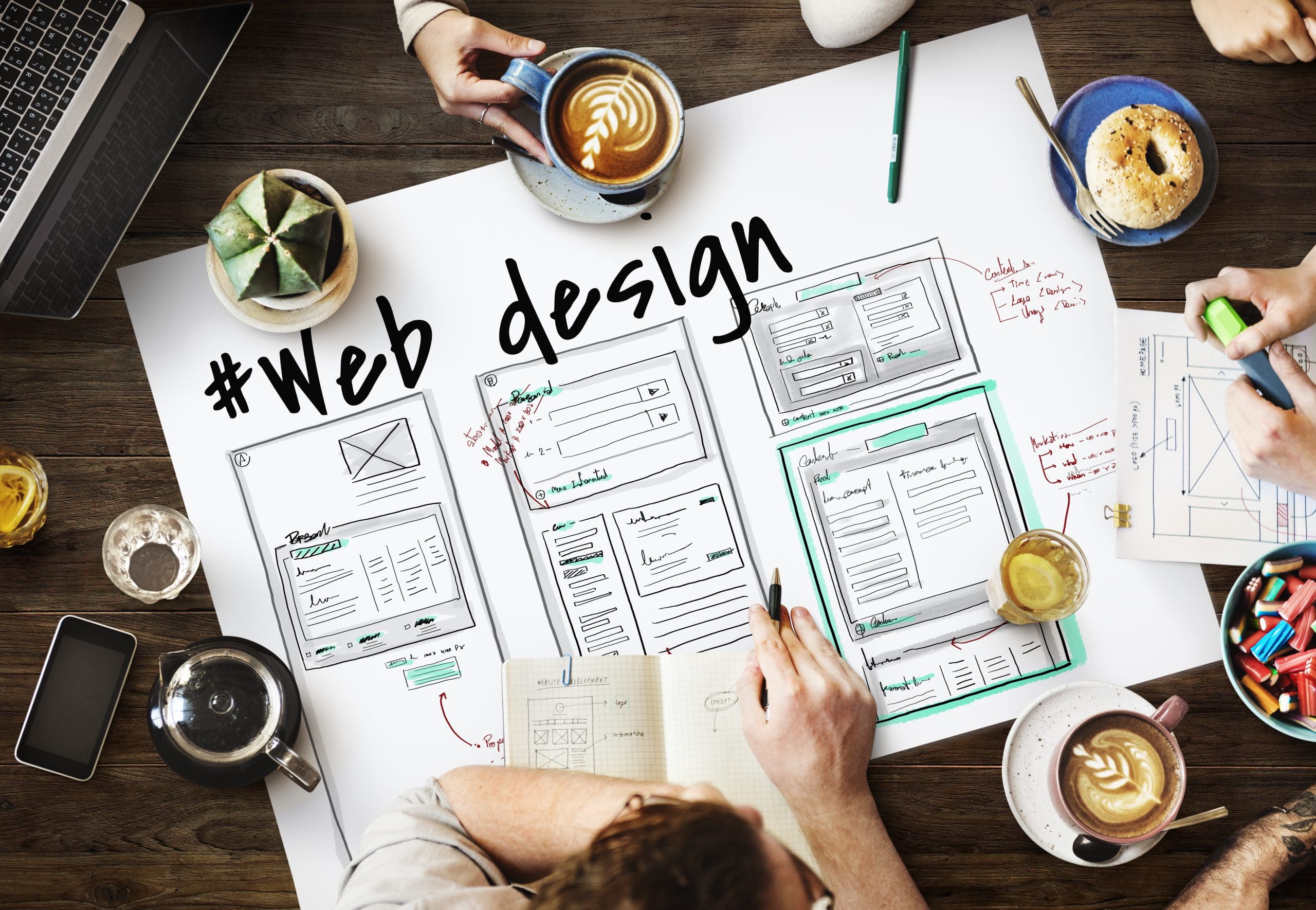Steps to optimize images and load speed for your web design company website
Discovering Imaginative Patterns in Web Design for Modern Businesses
The landscape of web design is continuously progressing, mirroring the vibrant needs of modern organizations. Current fads highlight a preference for minimalism, vibrant typography, and interesting interactivity. Business increasingly focus on user experience via mobile-first principles and tailored web content. Furthermore, a concentrate on sustainability is gaining grip. Comprehending these fads is crucial for companies aiming to attract attention in a jampacked marketplace. What ramifications do these shifts hold for the future of electronic involvement?
Accepting Strong Typography
Bold typography has actually become a specifying element in modern web design, recording attention and sharing messages with striking clarity. This trend focuses on visually impactful text that enhances user engagement and brand identity. Developers usually make use of one-of-a-kind fonts and oversized typefaces to develop a pecking order, directing audiences via web content effortlessly.
The tactical use strong typography enables efficient narration, making it possible for brand names to interact their worths succinctly. It offers not just aesthetic objectives but likewise functional ones, as it improves readability throughout gadgets and screen dimensions.
As web sites compete for user interest, bold typography stands out in a saturated electronic landscape. Its versatility makes it possible for designers to try out contrasting designs and shades, further enhancing its effectiveness. Eventually, accepting strong typography stands for a change towards more communicative and expressive web design, fostering a deeper connection in between brand names and their audiences.
The Surge of Minimalist Design
As electronic environments end up being increasingly messy, the increase of minimal layout uses a revitalizing option that focuses on simplicity and functionality. This layout philosophy remove unnecessary components, allowing material to take facility phase. By focusing on tidy lines, adequate white space, and a minimal shade combination, minimal style boosts user experience and enhances navigation.
Services embracing this pattern aim to share their brand message clearly and successfully, cultivating a sense of tranquility and quality. The lack of disturbances helps users focus on crucial information, causing boosted involvement and conversion prices. Additionally, minimal design straightens well with mobile-first methods, ensuring that internet sites continue to be obtainable and straightforward throughout different tools.
Inevitably, the rise of minimal design reflects a broader change towards prioritizing user needs and choices, making it an effective tool for contemporary services seeking to make a lasting impact in the digital landscape.
Immersive Animations and Interactivity
While lots of web designers accept minimalist looks, another compelling trend gaining traction is using immersive animations and interactivity. This strategy improves user involvement by developing intriguing experiences that attract site visitors right into the content. Designers employ dynamic aspects such as animated backgrounds, scrolling effects, and interactive infographics to interact complex ideas in an available fashion.
These animations not just provide aesthetic interest however likewise overview customers via the navigating procedure, making interactions extra user-friendly. As an example, hover results and animated shifts can motivate individuals to check out even more, bring about raised time invested in the site.
This pattern straightens with the more comprehensive motion in the direction of narration in web design, where computer animations offer as narrative gadgets that convey brand messages effectively. By incorporating immersive computer animations and interactivity, services can distinguish themselves in a crowded online landscape, ultimately improving user fulfillment and brand name loyalty.
Mobile-First Design Principles
Mobile-first style principles highlight focusing on user experience by making certain websites work effortlessly on smaller screens. This strategy includes receptive design strategies that adjust to numerous device sizes while keeping aesthetic integrity. Furthermore, it concentrates on touchscreen navigation style, improving usability for mobile users.
Prioritizing User Experience
Just how can developers efficiently focus on user experience in a significantly mobile-centric globe? Highlighting mobile-first layout principles is crucial, as individuals primarily engage with sites with mobile gadgets. This approach encourages developers to streamline material, guaranteeing it is navigable and quickly obtainable on smaller displays. Secret practices include streamlining navigation, decreasing load times, and employing touch-friendly elements that improve interactivity. In addition, focusing on clear typography and instinctive formats can substantially enhance user fulfillment. Developers need to continuously collect user comments to fine-tune their approaches, adjusting to advancing user requirements and choices. By concentrating on these components, services can create an engaging digital experience that fosters commitment and drives conversions, inevitably straightening with the assumptions these days's mobile users.
Receptive Format Techniques
Developers accept receptive format strategies to develop flexible and flexible internet experiences that deal with various screen sizes. This technique prioritizes mobile-first layout principles, ensuring peak capability on smaller sized gadgets before scaling up for larger displays. By utilizing fluid grids, flexible pictures, and media inquiries, developers can maintain a natural aesthetic identity across all platforms. This strategy not only enhances user engagement but likewise enhances internet search engine positions, as mobile-friendly sites are preferred by search formulas. Furthermore, receptive formats enable companies to reach a broader target market, suiting users on mobile phones, desktop computers, and tablets alike. On the whole, executing these strategies is important for modern web design, ensuring that companies stay affordable in an ever-evolving digital landscape.
Touchscreen Navigation Style
With the increase of smart phones, touchscreen navigation has come to be a basic facet of web design. Designers are increasingly taking on mobile-first concepts to enhance user experience and involvement. Website Design Agency. Effective touchscreen navigation focuses on bigger buttons and intuitive motions, allowing individuals to connect conveniently with web content. This strategy minimizes disappointment and urges exploration, as individuals can browse flawlessly with their fingers. Furthermore, incorporating swipe gestures and tap functionality accommodates the natural habits of mobile users. Responses systems, such as aesthetic hints and animations, boost use even more by validating actions. As touchscreens control user communications, utilizing these design aspects not only straightens with modern expectations however additionally promotes a more pleasurable and easily accessible surfing experience for all users
Personalized User Experiences
What makes a user really feel really engaged on a website? The solution typically hinges on personalized user experiences. By customizing web content and navigation to individual preferences, companies can create a purposeful link with their audience. This personalization can be accomplished with numerous methods, such as examining user actions, utilizing cookies, and providing customized suggestions based on previous communications.
Ecommerce platforms that recommend products based on browsing background not only enhance user experience yet also enhance conversion rates. Additionally, incorporating vibrant material that adjusts to the user's place or time of day can even more enrich involvement.
Furthermore, tailored introductions or messages can make users feel valued and understood. As modern-day services endeavor to stand apart in an affordable electronic landscape, welcoming personalized user experiences ends up being essential, fostering loyalty and motivating repeat brows through. Inevitably, this strategy transforms a conventional site into an interactive platform that reverberates with its audience.
Sustainability in Web Design
As the electronic landscape remains to develop, the significance of sustainability in look at more info web design has actually obtained substantial attention. Designers are progressively familiar with the environmental effect their productions can have, motivating a change in the direction of green practices (Web Design services). Sustainable web design concentrates on optimizing sites to lower energy consumption and carbon impacts. Techniques consist of utilizing minimalistic style concepts, optimizing pictures, and employing effective coding techniques to boost loading speeds
Additionally, the option of hosting providers plays an essential duty; several developers are now deciding for environment-friendly holding services powered by renewable resource. By prioritizing ease of access and user-friendly navigating, sustainable layouts additionally deal with a broader audience, enhancing functionality. This conscious strategy not only interest environmentally-minded customers yet additionally adds to the total long life and efficiency of web sites. Ultimately, sustainability in web design shows a growing fad in like it the direction of liable electronic techniques that straighten with modern organization values.

Often Asked Questions
Just How Can I Select the Right Color Pattern for My Web site?
To choose the best color pattern for a site, one must consider the brand's identification, target market, and psychological influence. Using shade theory and screening combinations can improve user experience and visual appeal substantially.
What Are the very best Tools for Prototyping Website Design?
The very best devices for prototyping website design include Figma, Sketch, Adobe XD, and InVision. These platforms use instinctive user interfaces, partnership attributes, and extensive collections, making them ideal for developers to produce and refine their concepts effectively.
How Do I Determine the Performance of My Web Design?
To determine web design performance, one should analyze user involvement metrics, conversion rates, and functionality feedback (Website Design Agency). A/B testing and heatmaps can likewise offer insights into user habits, leading essential modifications for better performance and user experience
What Are Common Web Design Blunders to Avoid?
Common web design blunders include messy layouts, bad navigation, slow-moving filling times, lack of mobile optimization, inadequate comparison, and disregarding user feedback. Preventing these risks improves user experience and boosts overall performance of the site.
Exactly how Commonly Should I Update My Web Site Style?
A site design should be upgraded every two to three years, or faster if significant adjustments in branding or innovation occur. Routine updates keep the website fresh, functional, and lined up with present user assumptions.
